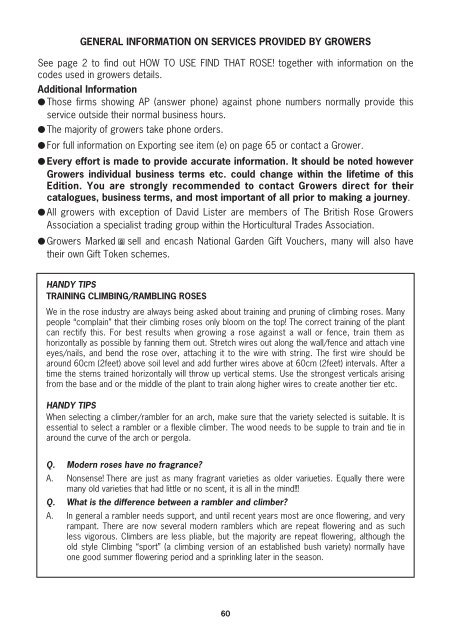THE GUIDE TO WHO GROWS WHAT - Roses UK
THE GUIDE TO WHO GROWS WHAT - Roses UK
THE GUIDE TO WHO GROWS WHAT - Roses UK
You also want an ePaper? Increase the reach of your titles
YUMPU automatically turns print PDFs into web optimized ePapers that Google loves.
GENERAL INFORMATION ON SERVICES PROVIDED BY GROWERS<br />
See page 2 to find out HOW <strong>TO</strong> USE FIND THAT ROSE! together with information on the<br />
codes used in growers details.<br />
Additional Information<br />
● Those firms showing AP (answer phone) against phone numbers normally provide this<br />
service outside their normal business hours.<br />
● The majority of growers take phone orders.<br />
● For full information on Exporting see item (e) on page 65 or contact a Grower.<br />
● Every effort is made to provide accurate information. It should be noted however<br />
Growers individual business terms etc. could change within the lifetime of this<br />
Edition. You are strongly recommended to contact Growers direct for their<br />
catalogues, business terms, and most important of all prior to making a journey.<br />
● All growers with exception of David Lister are members of The British Rose Growers<br />
Association a specialist trading group within the Horticultural Trades Association.<br />
● Growers Marked m sell and encash National Garden Gift Vouchers, many will also have<br />
their own Gift Token schemes.<br />
HANDY TIPS<br />
TRAINING CLIMBING/RAMBLING ROSES<br />
We in the rose industry are always being asked about training and pruning of climbing roses. Many<br />
people “complain” that their climbing roses only bloom on the top! The correct training of the plant<br />
can rectify this. For best results when growing a rose against a wall or fence, train them as<br />
horizontally as possible by fanning them out. Stretch wires out along the wall/fence and attach vine<br />
eyes/nails, and bend the rose over, attaching it to the wire with string. The first wire should be<br />
around 60cm (2feet) above soil level and add further wires above at 60cm (2feet) intervals. After a<br />
time the stems trained horizontally will throw up vertical stems. Use the strongest verticals arising<br />
from the base and or the middle of the plant to train along higher wires to create another tier etc.<br />
HANDY TIPS<br />
When selecting a climber/rambler for an arch, make sure that the variety selected is suitable. It is<br />
essential to select a rambler or a flexible climber. The wood needs to be supple to train and tie in<br />
around the curve of the arch or pergola.<br />
Q. Modern roses have no fragrance?<br />
A. Nonsense! There are just as many fragrant varieties as older variueties. Equally there were<br />
many old varieties that had little or no scent, it is all in the mind!!!<br />
Q. What is the difference between a rambler and climber?<br />
A. In general a rambler needs support, and until recent years most are once flowering, and very<br />
rampant. There are now several modern ramblers which are repeat flowering and as such<br />
less vigorous. Climbers are less pliable, but the majority are repeat flowering, although the<br />
old style Climbing “sport” (a climbing version of an established bush variety) normally have<br />
one good summer flowering period and a sprinkling later in the season.<br />
60


